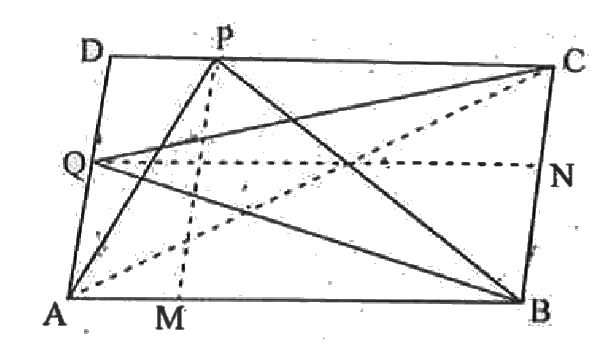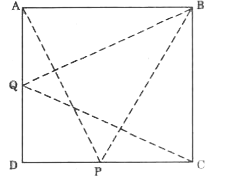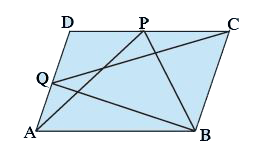P और Q क्रमशः समानान्तर चतुर्भुज ABCD की भुजाओं DC और AD पर स्थित बिंदु है। दर्शाइए कि - ar(APB)=ar(BQC)
Step by step video & image solution for P और Q क्रमशः समानान्तर चतुर्भुज ABCD की भुजाओं DC और AD पर स्थित बिंदु है। दर्शाइए कि - ar(APB)=ar(BQC) by Maths experts to help you in doubts & scoring excellent marks in Class 9 exams.
Topper's Solved these Questions
- BOOK - SHIVLAAL PUBLICATIONCHAPTER - आदर्श प्रश्न-पत्र : सेट - II EXERCISE - एक शब्द/वाक्य में उत्तर लिखिए5videos
आदर्श प्रश्न-पत्र : सेट - II
- BOOK - SHIVLAAL PUBLICATIONCHAPTER - आदर्श प्रश्न पत्र : सेट IV EXERCISE - प्रश्न उत्तर38videos
आदर्श प्रश्न पत्र : सेट IV
- BOOK - SHIVLAAL PUBLICATIONCHAPTER - चतुर्भुज EXERCISE - दीर्घ उत्तरीय प्रश्न1videos
चतुर्भुज
Similar Questions
am×an का सरलतम रूप लिखिए।
03:46View Solution3√18 परिमेय संख्या है अथवा अपरिमेय संख्या बताइए ।
04:38View Solutionदर्शाइए कि यदि एक चतुर्भुज के विकर्ण परस्पर समकोण पर समद्विभाजित करें तो वह एक समचतुर्भुज होगा।
05:04View SolutionP and Q are any two points lying on the sides DC and AD respectively of a parallelogramABCD. Show that ar (APB) = ar (BQC).
03:22View SolutionP और Q क्रमश : समांतर चतुर्भुज ABCD कि भुजाओ में DC और AD पर स्थित बिंदु है । दर्शाइए कि ar(APB)=ar(BQC) है |
05:01View SolutionP और Q क्रमशः समांतर चतुर्भुज ABCD की भुजाओं DC और AD पर बिन्दु है। दर्शाइए कि ar (APB) = ar (BQC) है।
03:51View SolutionP और Q किसी समांतर चतुर्भुज ABCD की भुजाओं DC तथा AD पर स्थित दो बिंदु है |दिखाएँ की ar(ΔAPB)=ar(ΔBQC)
01:50View SolutionP and Q are any two points lying on the sides DC and AD respectively of a parallelogram ABCD. Show that ar (APB) = ar (BQC).
 03:27View Solution
03:27View SolutionP and Q are any two points lying on the sides DC and AD respectively of a parallelogram , ABCD . Show that ar(APB) = ar (BQC)
 03:22View Solution
03:22View Solutionएक बिंदु P, x-अक्ष पर और एक अन्य बिंदु Q, y-अक्ष पर स्थित है। (i) बिंदु P की कोटि ज्ञात कीजिए।
02:41View SolutionP and Q are any two points lying on the sides DC and AD respectively of a parallelogram ABCD show that ar(ΔAPB)=arΔ(BQC)
 02:00View Solution
02:00View SolutionP and Q are any two points lying on the sides DC and AD respectively of a parallelogram ABCD show that ar(ΔAPB)=arΔ(BQC)
 03:56View Solution
03:56View SolutionP and Q are any two points lying on the sides DC and AD respectively of a parallelogram ABCD show that ar(ΔAPB)=arΔ(BQC)
 06:21View Solution
06:21View SolutionP and Q are any two points lying on the sides DC and AD respectively of a parallelogram ABCD. Show that ar (APB) = ar (BQC).
06:00View SolutionP ਅਤੇ Q ਕ੍ਰਮਵਾਰ ਸਮਾਂਤਰ ਚਤੁਰਭੁਜ ABCA ਦੀਆਂ ਭੁਜਾਵਾਂ DC ਅਤੇ AD ਉੱਤੇ ਸਥਿਤ ਬਿੰਦੂ ਹਨ। ਦਰਸਾਉ ਕਿ ar (APB) = ar (BQC) ਹੈ।
05:07View SolutionABCD is a cyclic quadrilateral such that its sides AD and BC produced meet at P and sides AB and DC produced meet at Q. If angle A=62^@ and angle ABC= 74^@ , then the difference between angle P and angle Q is: ABCD एक चक्रीय चतुर्भुज है जो इस प्रकार है कि इसकी भुजाओं AD और BC को बढ़ाने पर वे P पर मिलती हैं तथा AB और DC को बढ़ाने पर वे Q पर मिलती हैं | यदि angle =62^@ और angle ABC= 74^@ है, तो angle P और angle Q के बीच अंतर ज्ञात करें |
02:50View Solution

